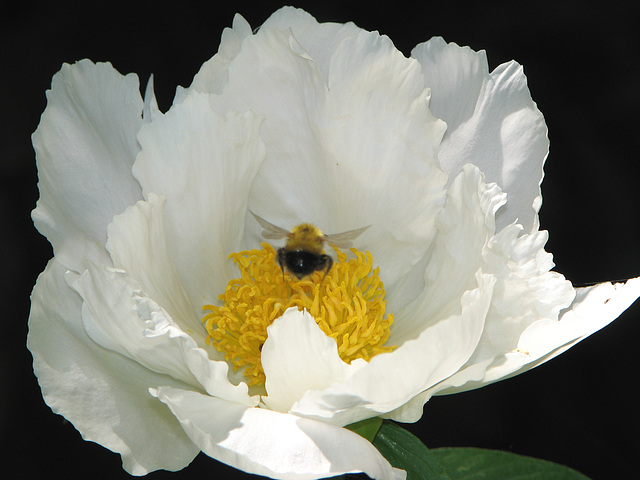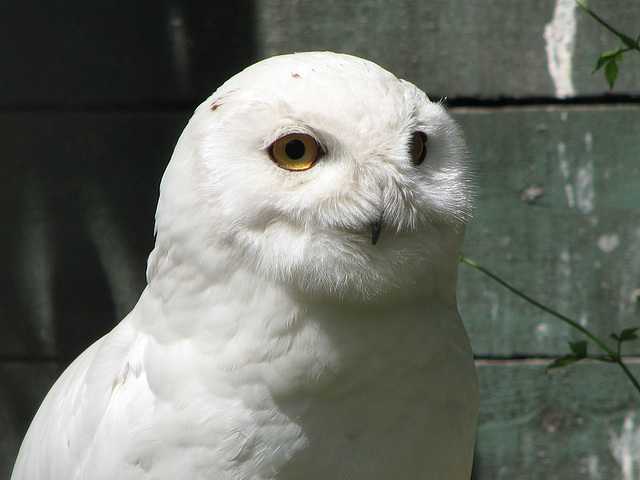
Calgary Zoo 1
02 Jul 2007
Great Grey Owl
This gorgeous Great Grey Owl sat out in the open on a tall, thin, dead tree branch/trunk when I visited the Calgary Zoo a week ago. It proceeded to preen itself, which was interesting to witness. It is such an amazing feeling to have these Owls flying or perched just a matter of feet away, with nothing between them and you.
02 Jul 2007
Busy bee
This little bee was busily hovering inside a large, white Peony in the garden at the Calgary Zoo.
08 Jul 2007
In style
These Demoiselle Cranes at the Calgary Zoo are so hard to photograph, as they are moving constantly. I didn't manage to get the face in complete focus, but I love the feathers in the "hair-do"!
"The Demoiselle Crane, Anthropoides virgo is a species of crane. It breeds in central Asia, with a few found in Cyprus and eastern Turkey, even far as western and Northern Pakistan and migrates to Africa and South Asia in winter.
The Demoiselle is 85-100 cm long with a 155-180 cm wingspan. It is therefore slightly smaller than the Common Crane, with similar plumage. However it has a long white neck stripe and the black on the foreneck extends down over the chest in a plume.
It has a loud trumpeting call, higher-pitched than the Common Crane. Like other cranes it has a dancing display, more balletic than the Common Crane, with less leaping.
During the breeding season, marshy areas are preferred living spaces, while the cranes are more commonly found in dry grasslands throughout the winter. The birds usually nest no more than 500 m away from a main source of water. Damp marshes, steppe habitats, and meadows are all other areas in which the Demoiselle Crane could be spotted in. The range in height goes from sea level to over 3,000 metres.
Demoiselle cranes have to take one of the toughest migrations in the world. In late August through September, they gather in flocks of up to 400 individuals and prepare for their flight to their winter range. During their migratory flight south, Demoiselles fly like all cranes, with their head and neck straight forward and their feet and legs straight behind, reaching altitudes of 16,000-26,000 feet (4,875-7,925 m). Along their arduous journey they have to cross the Himalayan mountains to get to their over wintering grounds in India, many die from fatigue, hunger and predation from birds such as eagles. At their wintering grounds, Demoiselles have been observed flocking with Common Cranes, their combined totals reaching up to 20,000 individuals. Demoiselles maintain separate social groups within the larger flock. In March and April, they begin their long spring journey back to their northern nesting grounds.
In Khichan in India, villagers feed the Cranes on their migration and these large congregations have become an annual spectacle.
The Demoiselle Crane is evaluated as Least Concern on the IUCN Red List of Threatened Species. It is one of the species to which the Agreement on the Conservation of African-Eurasian Migratory Waterbirds (AEWA) applies." From Wikipedia website.
08 Jul 2007
I think I am a Spectacled Owl
This Owl was perched inside the Nocturnal House at the Calgary Zoo when I was there yesterday. I was up till around 3:30 a.m. this morning, trying to identify it, but in the end had to give up. Perhaps it is a juvenile of a species. The shape of the white markings around the eyes makes me think of a Hawk Owl of some kind. I would be thrilled to bits if someone can tell me what this gal/guy is!
Added later on 9th July: I think I have found out what this owl is - a Spectacled Owl!
"The Spectacled Owl, Pulsatrix perspicillata, is a large tropical owl. It is a resident breeder from southern Mexico and Trinidad south to southern Brazil, Paraguay and northwestern Argentina. There are six subspecies.
This is nocturnal species of mature forests. It nests in an unlined tree cavity, laying two white eggs. It preys on mammals and large insects, and will also take birds, including smaller owls.
The Spectacled Owl is 46 cm long and weighs 850 g. It is unmistakable with brown upperparts, head and upper breast, white facial markings and buff underparts. The eyes are yellow and the bill is pale. The juvenile is even more distinctive than the adult, being completely white apart from a chocolate brown facial disc.
The call is a deep hooting BOO Boo boo boo boo becoming softer and faster."
From Wikipedia website.
08 Jul 2007
Grey Crowned Crane
These birds are in an enclosure at the Calgary Zoo, unfortunately behind dirty glass/plastic, which makes photos difficult to take. Just love the wonderful crest that these birds have - reminds me of an old-fashioned shaving brush, or maybe a dandelion seedhead!
"The Grey Crowned Crane (Balearica regulorum) is a bird in the crane family Gruidae. It occurs in dry savannah in Africa south of the Sahara, although it nests in somewhat wetter habitats.
There are two subspecies. The East African B. r. gibbericeps (Crested Crane) occurs from eastern Democratic Republic of the Congo through Uganda, of which it is the national bird, and Kenya to eastern South Africa. It has a larger area of bare red facial skin above the white patch than the smaller Balearica regulorum regulorum (South African Crowned Crane) which breeds from Angola south to South Africa.
This species and the closely related Black Crowned Crane are the only cranes that can roost in trees, because of a long hind toe that can grasp branches. This habit, amongst other things, is a reason why the relatively small Balearica cranes are believed to closely resemble the ancestral members of the Gruidae.
The Grey Crowned Crane has a breeding display involving dancing, bowing, and jumping. It has a booming call which involves inflation of the red gular sac. It also makes a honking sound quite different from the trumpeting of other crane species.
The nest is a platform of grass and other plants in tall wetland vegetation. The Grey Crowned Crane lays a clutch of 2-5 eggs. Incubation is performed by both sexes and lasts 28-31 days. Chicks fledge at 56-100 days.
The Grey Crowned Crane is about 1 m (3.3 ft) tall and weighs 3.5 kg (7.7 lbs). Its body plumage is mainly grey. The wings are also predominantly white, but contain feathers with a range of colours. The head has a crown of stiff golden feathers. The sides of the face are white, and there is a bright red inflatable throat pouch. The bill is relatively short and grey, and the legs are black. The sexes are similar, although males tend to be slightly larger. Young birds are greyer than adults, with a feathered buff face. Like all cranes, it feeds on insects, reptiles and small mammals.
Although the Grey Crowned Crane remains common over much of its range, it faces threats to its habitat due to drainage, overgrazing, and pesticide pollution.
The Grey Crowned Crane is the national bird of Uganda and features in the country's flag and coat of arms."
From Wikipedia website.
02 Jul 2007
Got my eyes on YOOOO
One of the large Great Grey Owls in the aviary at the Calgary Zoo. Sometimes, they can be sitting 8' or 10' away from you, with nothing between them and you. Quite a feeling looking into those small, piercing eyes. I think I counted four of these Owls - along with a Barred Owl and a rescued Snowy Owl.
02 Jul 2007
Male Snowy Owl
The Snowy Owls at the Calgary Zoo were almost impossible to photograph today, hiding behind the tall grass and Rhubarb plant! Just managed to get a quick shot of the male.
08 Jul 2007
Southern Bald Ibis
These birds, along with other species, are free to roam in part of one of the fairly new African buildings at the Calgary Zoo. While we do not get these birds in the wild, if one is very lucky, one can see a White-faced Ibis south of the city. I rather like this photo in Large size : )
Jump to top
RSS feed- Latest items - Subscribe to the latest items added to this album
- ipernity © 2007-2024
- Help & Contact
|
Club news
|
About ipernity
|
History |
ipernity Club & Prices |
Guide of good conduct
Donate | Group guidelines | Privacy policy | Terms of use | Statutes | In memoria -
Facebook
Twitter










